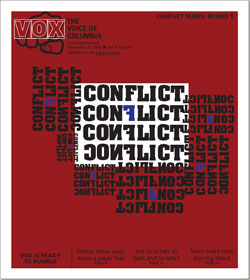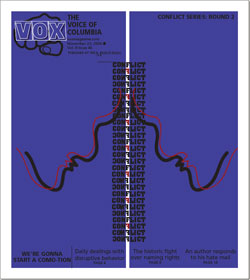Journalism Students, Local News Outlets Provide Multimedia Coverage of Community Conflict
Columbia, Mo. (March 2, 2007) — A new collaborative effort between the University of Missouri-Columbia’s Center for the Study of Conflict, Law and the Media and Vox magazine recently challenged students at the Missouri School of Journalism to apply convergence journalism skills to the study of conflict in the community.

The 24 students enrolled in the School’s Journalism and Conflict course during the fall 2006 semester worked with the staff of Vox, a weekly Columbia city magazine, to publish two special issues devoted entirely to community conflicts. Vox is produced by the School’s magazine journalism students and faculty.
One story, for instance, examined local professionals, such as attorneys and social workers, whose careers revolve around conflict. Another looked at the Columbia bar scene, which is surprisingly fight-free.
In addition to publishing their stories in Vox, the reporters practiced convergence journalism by broadcasting their stories on KBIA, Columbia’s award-winning NPR station, which also uses its facilities as a working laboratory for Missouri Journalism students.
“It’s a cutting-edge curriculum enhancement that focuses on the new trends of interest-based reporting and convergence journalism,” said Michael Grinfeld, associate professor of magazine journalism, adjunct associate professor at the MU School of Law and co-director of the Center for the Study of Conflict, Law and the Media. Grinfeld also teaches Journalism and Conflict.
Although Grinfeld has taught the course since 2002, this was the first semester his students teamed up with Vox. The collaboration is a reflection of the School’s traditional “Missouri Method” of journalism instruction, which emphasizes hands-on media training.
“I wanted to link the work they were doing with actual media,” Grinfeld said.
Judy Bolch, the Harte Chair in Journalism and Vox editorial director, guided the student editors at the magazine as they moved the articles through the publication process. The final product was a two-part series in back-to-back issues that included feature articles, photographs and book reviews.
The Center for Conflict,
Law and the MediaIn the past two decades, both the journalistic and legal professions have experienced rapid change. Journalism has witnessed a technological revolution, the dawn of a non-stop news cycle and increased corporate consolidation. Meanwhile, the practice of law has moved beyond traditional advocacy toward new methods of dispute resolution, such as negotiation, mediation and arbitration.The University of Missouri’s Center for Conflict, Law and the Media stands at the cutting edge of this transformation. The Center maintains an aggressive research, teaching and outreach agenda aimed at fostering a better understanding of the experience, reporting, management and impact of conflict in the United States and beyond.
The Center’s scholars are members of the faculties of the Missouri School of Journalism and School of Law. Michael Grinfeld, associate professor of magazine journalism and adjunct associate professor of law, and Richard Reuben, associate professor of law, are co-directors.
Community conflicts were not the only disputes the students studied, however. They also dealt with conflicts that came up during the production process, such as negotiating with sources, classmates, designers and editors. These few “bumps along the way” reflected the real conflict resolution process that must occur during the publication of any magazine, Bolch said.

“I’m sure the writers and our customers learned a lot about viewing conflict in different ways and about how conflict permeates every aspect of our society,” Bolch said.
Students spent the first half of Grinfeld’s course learning the foundations of conflict theory, which mirrors the law school’s highly recognized dispute resolution coursework. During the second half of the semester, students put theory into practice by applying these skills in everyday situations, including role-play scenarios that place the students in realistic conflicts they are likely to encounter during their careers.
“The purpose is to teach journalists how to better evaluate conflict so their work is more insightful, contextualized and accurate,” Grinfeld said.
Students who participated in the project have indicated that the training was especially relevant as they prepare to enter the full-time workforce.
“I think it was one of the most rewarding reporting experiences I’ve ever had,” said Julie Wyatt, a senior newspaper journalism major from Mexico, Mo. “The project is designed to teach students about negotiating through conflicts — and it definitely did that. Now, when I’m working on a story, I’m much more thoughtful and tactful in the questions I ask and the way I think about issues.”
Grinfeld said he plans for his class to participate in a similar project during the fall 2007 semester.
Updated: April 16, 2020